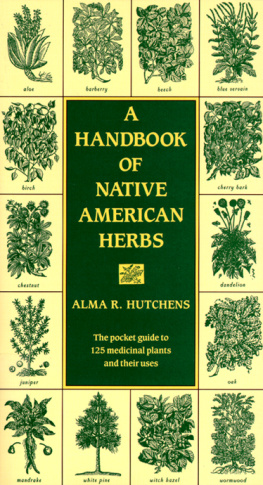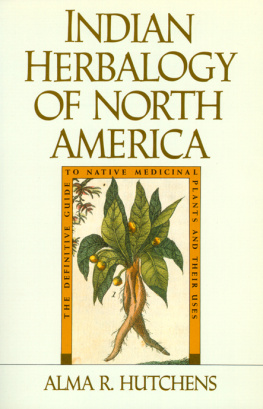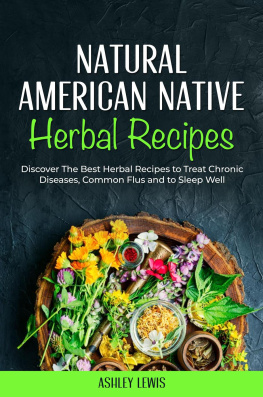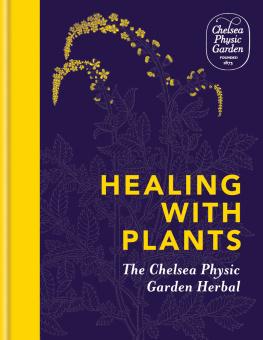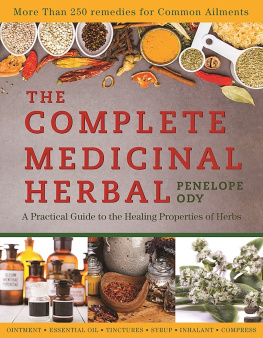ABOUT THE BOOK
This authoritative guidebased on the authors classic reference work, Indian Herbalogy of North Americais a portable illustrated companion for the professional and amateur herbalist alike. It provides detailed descriptions of 125 of the most useful medicinal plants commonly found in North America, along with directions for a range of uses, remedies for common ailments, and notes on the herbal traditions of other lands. Entries include staples of folk medicine such as echinacea and slippery elm as well as common kitchen herbssuch as parsley, thyme, and pepperwhose tonic and healing properties are less widely known.
ALMA R. HUTCHENS, a close associate of the late herbalist N. G. Tretchikoff, has been a student and practitioner of herbal medicine for many years.
Sign up to learn more about our books and receive special offers from Shambhala Publications.

Or visit us online to sign up at shambhala.com/eshambhala.

Shambhala Publications, Inc.
Horticultural Hall
300 Massachusetts Avenue
Boston, Massachusetts 02115
www.shambhala.com
1992 by Alma R. Hutchens
All rights reserved. No part of this book may be reproduced in any form or by any means, electronic or mechanical, including photocopying, recording, or by any information storage and retrieval system, without permission in writing from the publisher.
Library of Congress Cataloging-in-Publication Data
Hutchens, Alma R.
A handbook of native American herbs/Alma R. Hutchens.1st ed.
p. cm.
Includes bibliographical references and index.
eISBN 978-0-8348-2422-5
ISBN 0-87773-699-5 (acid-free paper)
1. Indians of North AmericaEthnobotanyHandbooks, manuals, etc. 2. HerbsNorth AmericaHandbooks, manuals, etc. 3. EthnobotanyNorth AmericaHandbooks, manuals, etc. I. Title.
E98.B7H87 1992 9250122
615.321097dc20 CIP
Each book has its own fate and destiny, Alma Hutchens observed in the preface to her classic, Indian Herbalogy of North America. The prescience of that statement will be evident to those who have watched Mrs. Hutchenss work unfold in the thirty years since she began her research under the tutelage of her mentor, the noted herbalist N. G. Tretchikoff. Indian Herbalogy, first published in the 1960s, came at a time of burgeoning interest in folk medicine and natural healing methods, and it met the need for a detailed reference book for North American herbalists. It has since become known as a standard work on the subject in many countries and has gone through seventeen printings as of 1992.
As the years have gone by and interest in herbs and their uses has increased, the need for a portable version of Indian Herbalogy has been felt. It is with this need in mind that Mrs. Hutchens has compiled this Handbook of Native American Herbs. In it are found descriptions of 125 of the most useful medicinal plants commonly found on the North American continent. Included are dosages, directions for use, remedies for some common ailments, homeopathic methods, and lore from the folk medicine of other countriesparticularly Russia, China, India, and Pakistanwhere the arts of herbal healing have traditionally flourished.
The fate and destiny of Alma Hutchenss work in herbology has proven to be its enduring influence in the field. A Handbook of Native American Herbs represents the latest phase in that unique destiny.
Glechoma hederacea
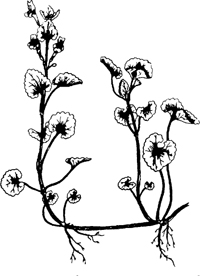
COMMON NAMES: Cats foot, gill go by ground, gill creep by ground, turn hoof, hay maids. Various names come from the many localities in which it grows.
FEATURES: The plant is common to North America and Europe. Found in shady places, waste grounds, dry ditches, in almost every part of the land. The green, round leaves endure every season except when the temperature falls below the freezing point.
MEDICINAL PART: Leaves.
SOLVENT: Water.
BODILY INFLUENCE: Stimulant, tonic, pectoral.
USES: A singular herb for all inward wounds, ulcerated lungs, or other parts indicating the same condition. Either by itself or boiled with other herbs and drinks.
In a short time it will ease all gripping pains, gas, and choleric conditions of the stomach and spleen. Useful in yellow jaundice, as it opens the stoppage of the gall bladder and liver, and in melancholy, by relieving obstructions of the spleen; expels poisons and also the plague; encourages a release of urine and relieves womens complaints.
A decoction of ale hoof and a good wine taken over a period of time will ease sciatica, hip gout, or arthritic hands and knees. A decoction with honey and a little burnt alum is excellent as a gargle for sore mouth or throat and to wash genital sores and ulcers. An infusion of the leaves is very beneficial in lead colic. Painters who make use of it are seldom, if ever, troubled with this malady. The fresh juice snuffed up the nose often takes care of most deep-rooted, long-established headaches.
This is one of the most wonderful of all herbs. The mineral content includes iron, copper, iodine, phosphorus, and potassium. The ancient herbalists praised it greatly, saying it would cure insanity and melancholia by opening the stopping of the spleen. It also regulates the heartbeat by making the blood more fluid. An excellent assistant to aid glandular health and prevent premature aging.
DOSE: 1 teaspoonful to 1 cup boiling water; powder, dram to 1 dram.
EXTERNALLY: The fresh leaf bruised and bound around a new wound will hasten an early recovery. Ale hoof juice, honey, and marigold (Calendula) boiled together will clean fistulas and ulcers, control the spreading or eating away of cancers and ulcers, and relieve itching scabs, weals, and other skin irritations in any part of the body. The juice dropped into the ear has been used for treatment of ringing in the ears and cleansing in cases of impaired hearing due to infection.
Medicago sativa
COMMON NAMES: Lucern, buffalo herb.
FEATURES: Alfalfa is native to Asia and did not reach North America until around 1850 or 1860. This deep-growing plant is seen from Maine to Virginia and westward to the Pacific coast in the United States.
The Native Americans adapted alfalfa quickly for human use as well as for animals. In England and South Africa it is called buffalo herb.
This is a perennial, herbaceous plant, with two stems. Leaflets: three-toothed above. Flowers: violet. Calyx: five-toothed. Corolla: papilionaceous, six lines long. Stamens: nine united and one free. Pod: spirally coiled and without spines. The small, violet-purple or bluish flowers bloom from June until August. In some regions it is cut every month as cultivated food for both man and animal.
The organic salt of alfalfa is among the richest known, the depth and spread of its roots enabling it to absorb its valuable nutrition as far as 125 feet below the earths surface.
USES: Alfalfa was discovered by the Arabs and is one of the first known herbs. They called it the Father of all Foods. It is only in recent years that we moderns are rediscovering its valuable nutritive properties, which include organic minerals of calcium, magnesium, phosphorus, and potassium, plus all the known vitamins, including vitamin K and the recently discovered vitamin B8 and vitamin P.
Next page
